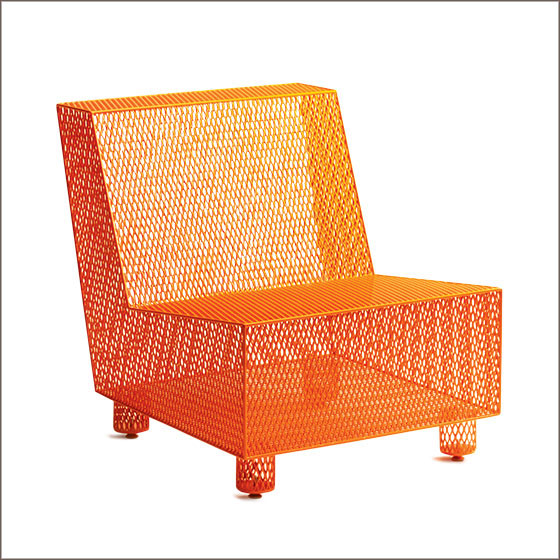
Yesterday, a reader alerted us to the possible dangers of wooden shipping pallets, especially found ones that are so great for d-i-y projects.
When we read that even new wood pallets could be subject to chemical treatments, we did some research to figure out how we can happily keep making things out of wood pallets, which we view as a sort of Lego for grownups: the perfect building block. So here is the best info we have on navigating found pallets (with some additional info woven in just this morning), plus a great source of pure wood pallets.
We discovered that the shipping pallets you find at the dump or on the street could be problematic. They could
a) have been exposed to potentially toxic bacteria from food, animals, or drug residues from whatever they were used for etc.
b) be made from pressure-treated wood, a chemical heat-treating process sometimes used to make them more durable and prevents insect infestation (used mainly for international shipments). That makes them something you probably don’t want inside the house unless you seal them to prevent possible exposure to the chemicals. Heat-treated pallets “bears the initials HT near theIPPC logo (the regulatory agency that oversees international pallets); the problem is that pressure-treating is only one of the kinds of heat treatments allowable; it will not be indicated by the stamp). If you happen to know what pressure-treated wood looks like, you can just avoid this wood.
c) have been fumigated with potentially toxic insecticides to prevent insect infestation (for pallets that have been shipped internationally). Pallets fumigated with methyl bromide bear the initials MB near the IPPC logo. As of March 19, 2010, the use of Methyl Bromide has been phased out.
There’s no way for us to gauge how great the dangers really are, although they don’t seem that dire to us. The gist, like just about everything these days: use found pallets according to your own good judgement and comfort level. Reading our Projects Consultant Nina Saltman‘s comments, below, should allay some fears as well.
If you’re nervous about using found pallets, you can buy chemical-free wood pallets at Uline,”the Shipping Supply Specialist”, whose mail-order catalogue we find endlessly inspiring. They sell pallets made from new wood (from a non-coniferus northern hardwood, such as oak, elm, maple, or cottonwood) or recycled wood (a mix of any of these woods). If you want to prevent any kind of insect activity, you can buy the pallets heat-treated, which means they’ve been heated to a certain temperature – without chemicals.
Whew!
Now, here’s what Nina Saltman had to say about the matter:
“I am not an expert on pallets, but this is what I DO know…mostly from having worked in warehousing (previous lifetime), and receiving pallets: Most common pallets that I am familiar with are NOT pressure treated, or treated in any way. They are usually C-grade lumber material with many flaws (known as checks, pits, and knots). They are often very rough lumber. There are those pallets that I have seen, that are much heavier duty, that are thicker dimensioned lumber, and in some cases have been pressure treated. Pressure treated should not be confused with fire treated. There are many different ways of treating lumber. The link following is “simplified pressure treated 101”. http://www.naturalhandyman.com/iip/infxtra/infpre.html
So then the next question is whether you can seal it etc. The short answer is Yes. The longer answer is that often times pressure treated lumber has these little hatch marks all along the wood surface. It is not especially good looking, and is hard, if not impossible to fill, sand out, or disguise. That being said you can paint, seal stain etc. pressure treated like any other type, it just may look darker, as the pressure treating usually darkens the wood already…I do not think that short term, occasional handling of pressure-treated wood is a problem. If I handle treated lumber for any length of time, or project, I usually wear gloves and wash my hands before I eat. I would not recommend treated lumber near food, but do not think of it as a hazard for general building useage. I used it on the foundation, and deck framing lumber for our shed, for instance.”
Click here to read about the pallet house above, designed as disaster relief (what about those pallets?)
Related posts: PS: Some Possible Dangers of Wood Shipping Pallets




Look up pallets on wikipedia – lots of information but most importantly – they are all stamped with a code that will tell you if they have been treated with chemicals or heat treated.
CLARIFICATION. Helen, Thanks for this excellent info. We didn’t think to consult Wikipedia about this (!?!). The pallets with the Heat Treating Stamp do “the initials HT near the IPPC logo”. The problem is that pressure-treating (which uses chemicals) is one of the kinds of heat treatments allowable. According the Nina Saltman, pressure-treated wood tends to be a big darker than most, if you know what it looks like, you can figure out your pallet.
Pallets fumigated with methyl bromide bear the initials MB near the IPPC logo. “From 19 March 2010 the use of Methyl Bromide as an acceptable treatment according to ISPM15 [25] has now been phased out.”
Pallets made of non-wood materials such as engineered wood products like plywood, exempt from ISPM 15 regulations.
We’ll incorporate this info into the post to make sure people can find it. Thanks again.
Hmm – I have not seen anything about pressure treating being an acceptable form of heat treating. I looked at a couple of pallet sites and it looks like heating in a kiln to a specific temp for a specific amount of time is the only method of heat treating. Not trying to be nitpicky – I’ve recently come across and easily accessible source of pallets (and bought a reciprocating saw) and want to find out for my own projects where chemical contact would not be okay.
where do you get your pallets?
If you read about 3/4 of the way down, you’ll see our favorite source for chemical-free wood pallets, Uline: chemical-free wood pallets at Uline. Otherwise, if we find a good-looking one on the street, which read it’s markings to see if it is one of the safe kind.
A fascinating look at a the different variety of pallets.
I recommend checking out the pictures of how these folks sanded the pallets to a furniture grade finish.
Of course I built my project BEFORE hearing about the possible dangers of palette wood! I built a headboard out of palette wood that was discarded at a mechanic shop down the street. It was used to ship lawn equipment. I cleaned it off and sealed it with a polyurethane stain. In an initial attempt to find IPPC logos, I struck out. Is my only other option to give it the eyeball test to determine if it is pressure treated? If I sealed it with this stain, does that help at all? Thanks.
I would think that poly would help seal it, but can’t say for sure. If it was water-based, it will have less ability to do that. I recommending doing a search on the internet, not necessarily re pallets but re sealing with polyeurathae to prevent contamination or something like that. Best of luck.
So, I know this is quite an old post, but… I am having a hard time finding some info about what type of pallets I might have.
I can get a ton of pallets at work, and I have compiled quite a list of cool things I want to do with them. Many of the pallets are in great shape, but I have avoided taking them home yet since I want to make sure they are safe. The thing is that many of the perfect pallets have absolutely no markings of any sort on them. I’m not really sure what this means as far as how or if they are treated.
I would think that if they are treated in any way they would have to have some sort of markings on them. My hope is that this means they are safe to use. The pallets are used to ship large medical equipment, so I am fairly confident that they have never been in contact with food. And the ones I am interested in all come from a manufacturer here in the US. So I would also assume that they are not using pallets that are intended to be shipped internationally.
Anyone have any insight on pallets with no markings at all?
I believe that treated pallets would have a stamp on them. You said “they all come from a manufactuer here in the US”. If you can find out the name of the manufacturer, you can just call them up.
In addition to the info in our post, googling “shipping pallets with no markings” yields a lot of info.
Please let us know what you find out…
And what you make.
Best, Sally
I have been googling all afternoon. LOL. I just hadn’t found anything definitive yet. Maybe I wasn’t using the right search terms if you saw some info. Might try again.
I will have to watch when new items come in. We only have one manufacturer that ships from overseas, and I know which pallets those are in our warehouse and they do all have a HT mark on them – so I know it is not that one. As far as which manufacturer the unmarked pallets are coming from though, I can’t pinpoint it yet as all of the equipment has already been removed from those. :/
Thanks for the reply!
I want to use old pallets for my bathroom wall. I have found so many articles on what to look for but not one explaining the symptoms resulting from working with chemically treated pallets. Can you please tell me how one knows if they have been affected with chemically treated pallets? I would so appreciate it 🙂
I have read about allergic reactions to pallet chemicals. As with any chemicals, the effect doesn’t always show up right away. I think it would be best to follow guides for using SAFE shipping pallets.
I never really considered that wooden pallets could be chemically altered to prevent bug infestations! You’re right– if used for the wrong reasons, they could be dangerous. I recommend doing research about the place you plan on getting your pallets first!